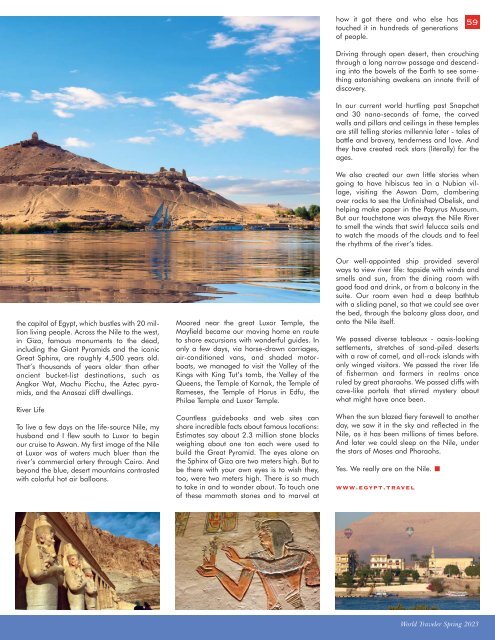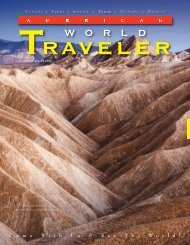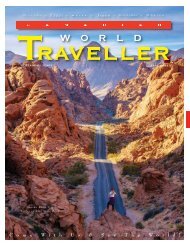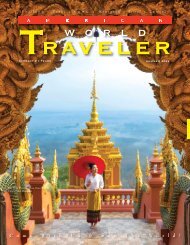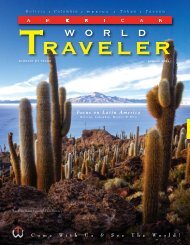Canadian World Traveller Spring 2023 Issue
Now in our 21st year of publishing, Canadian World Traveller explores the culture and history of worldwide destinations, sharing the adventure of discovery with our readers and motivating them to make their travel dreams a reality. Published quarterly, CWT helps sophisticated, independent Canadian travellers choose their next destination by offering a lively blend of intelligent, informative articles and tantalizing photographic images from our World’s best destinations, cruises, accommodations and activities to suit every traveller's taste.
Now in our 21st year of publishing, Canadian World Traveller explores the culture and history of worldwide destinations, sharing the adventure of discovery with our readers and motivating them to make their travel dreams a reality. Published quarterly, CWT helps sophisticated, independent Canadian travellers choose their next destination by offering a lively blend of intelligent, informative articles and tantalizing photographic images from our World’s best destinations, cruises, accommodations and activities to suit every traveller's taste.
Create successful ePaper yourself
Turn your PDF publications into a flip-book with our unique Google optimized e-Paper software.
how it got there and who else has<br />
touched it in hundreds of generations<br />
of people.<br />
59<br />
the capital of Egypt, which bustles with 20 million<br />
living people. Across the Nile to the west,<br />
in Giza, famous monuments to the dead,<br />
including the Giant Pyramids and the iconic<br />
Great Sphinx, are roughly 4,500 years old.<br />
That’s thousands of years older than other<br />
ancient bucket-list destinations, such as<br />
Angkor Wat, Machu Picchu, the Aztec pyramids,<br />
and the Anasazi cliff dwellings.<br />
River Life<br />
To live a few days on the life-source Nile, my<br />
husband and I flew south to Luxor to begin<br />
our cruise to Aswan. My first image of the Nile<br />
at Luxor was of waters much bluer than the<br />
river’s commercial artery through Cairo. And<br />
beyond the blue, desert mountains contrasted<br />
with colorful hot air balloons.<br />
Moored near the great Luxor Temple, the<br />
Mayfield became our moving home en route<br />
to shore excursions with wonderful guides. In<br />
only a few days, via horse-drawn carriages,<br />
air-conditioned vans, and shaded motorboats,<br />
we managed to visit the Valley of the<br />
Kings with King Tut’s tomb, the Valley of the<br />
Queens, the Temple of Karnak, the Temple of<br />
Rameses, the Temple of Horus in Edfu, the<br />
Philae Temple and Luxor Temple.<br />
Countless guidebooks and web sites can<br />
share incredible facts about famous locations:<br />
Estimates say about 2.3 million stone blocks<br />
weighing about one ton each were used to<br />
build the Great Pyramid. The eyes alone on<br />
the Sphinx of Giza are two meters high. But to<br />
be there with your own eyes is to wish they,<br />
too, were two meters high. There is so much<br />
to take in and to wonder about. To touch one<br />
of these mammoth stones and to marvel at<br />
Driving through open desert, then crouching<br />
through a long narrow passage and descending<br />
into the bowels of the Earth to see something<br />
astonishing awakens an innate thrill of<br />
discovery.<br />
In our current world hurtling past Snapchat<br />
and 30 nano-seconds of fame, the carved<br />
walls and pillars and ceilings in these temples<br />
are still telling stories millennia later - tales of<br />
battle and bravery, tenderness and love. And<br />
they have created rock stars (literally) for the<br />
ages.<br />
We also created our own little stories when<br />
going to have hibiscus tea in a Nubian village,<br />
visiting the Aswan Dam, clambering<br />
over rocks to see the Unfinished Obelisk, and<br />
helping make paper in the Papyrus Museum.<br />
But our touchstone was always the Nile River<br />
to smell the winds that swirl felucca sails and<br />
to watch the moods of the clouds and to feel<br />
the rhythms of the river’s tides.<br />
Our well-appointed ship provided several<br />
ways to view river life: topside with winds and<br />
smells and sun, from the dining room with<br />
good food and drink, or from a balcony in the<br />
suite. Our room even had a deep bathtub<br />
with a sliding panel, so that we could see over<br />
the bed, through the balcony glass door, and<br />
onto the Nile itself.<br />
We passed diverse tableaux - oasis-looking<br />
settlements, stretches of sand-piled deserts<br />
with a row of camel, and all-rock islands with<br />
only winged visitors. We passed the river life<br />
of fisherman and farmers in realms once<br />
ruled by great pharaohs. We passed cliffs with<br />
cave-like portals that stirred mystery about<br />
what might have once been.<br />
When the sun blazed fiery farewell to another<br />
day, we saw it in the sky and reflected in the<br />
Nile, as it has been millions of times before.<br />
And later we could sleep on the Nile, under<br />
the stars of Moses and Pharaohs.<br />
Yes. We really are on the Nile.<br />
www.egypt.travel<br />
<strong>World</strong> Traveler <strong>Spring</strong> <strong>2023</strong>


